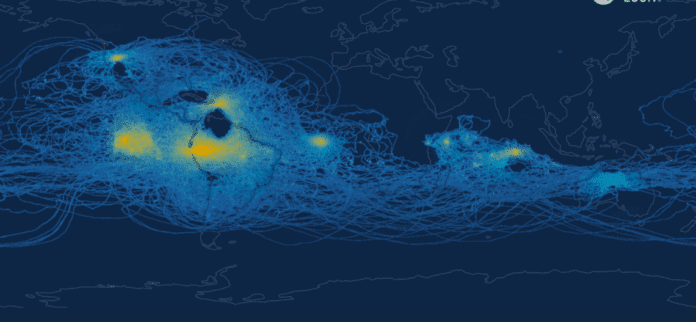HAPS Alliance includes Ericsson, Nokia, SoftBank, DT, Telefonica, China Telecom, Bharti Airtel and Loon, among others
A coalition of companies are aiming for the stratosphere as a “multi-billion dollar market opportunity” in telecommunications, planetary observation and weather prediction and modeling—including five traditionally terrestrial cellular network operators and two major telecom infrastructure vendors.
In a post on Medium and a new white paper, the recently formed HAPS (High Altitude Platform Stations or High-Altitude Pseudo-Satellites) Alliance laid out what is described as a “rare, untapped commercial opportunity in the skies above Earth’s atmosphere.” That Alliance includes Alphabet’s Loon and Japan’s SoftBank, which have collaborated via HAPSMobile, a SoftBank subsidiary, on modifying a HAPS payload so that telecom equipment can be carried. But it also includes network equipment companies Nokia and Ericsson, as well as carriers China Telecom, Deutsche Telekom, Telefónica and Bharti Airtel.
While space technology and the use of satellites has matured in recent years, the HAPS Alliance says, the stratosphere — where temperatures can be as low as -65 degrees Celsius and wind speeds can be greater than 40 kilometers an hour — has still been seen as unsuitable for large-scale commercial operations. Recent advances advances in solar, battery and artificial intelligence technologies have made it possible to design stratospheric vehicles, however, and multiple companies are now looking at the possibilities of the stratosphere. Loon’s balloons may be the best-known, but Airbus, Boeing and HAPSMobile have also developed fixed-wing HAPS aircraft that fly in the stratosphere.
“The untapped opportunities of the stratosphere are immense. While just ten years ago it seemed an inhospitable place for almost all activities, technology is now enabling us to harness the unique advantages of the stratosphere for a wide range of commercial operations. It’s an exciting time to be on the forefront of this exploration enabled by innovation,” said Alastair Westgarth, CEO of Loon.
The HAPS Alliance says that one of the key uses for HAPS will be providing internet services that sidestep the limitations of terrestrial wireless networks and satellite offerings, to connect the 3.8 billion people on Earth without access to the internet, providing 5G and internet of things services as well.
“Densely populated urban areas challenge the capacities of satellite infrastructure, while in remote, sparsely populated and hard-to-reach areas, ground-based cell towers aren’t cost-effective to deploy,” the alliance said. “HAPS can help telecom service providers expand coverage to meet the needs of these demanding markets. HAPS can act as floating cell towers, providing network latency that is comparable to that of terrestrial cell towers but with up to 200 times the geographic coverage from a single vehicle. At an altitude of just 20 km, HAPS can connect directly to mobile handsets, modems and IoT devices using standard 4G LTE and 5G protocols. In addition to expanding telecom coverage into rural and challenging terrains, HAPS operate above the weather and can be moved at will, enabling flexibility in the coverage area and emergency coverage in times of outages and disasters.
“Ultimately, the stratosphere can drive significant growth in the $3.9T mobile technologies and services business by bringing millions of people living in unconnected areas online, reconnecting people after disasters, building out the next generation of 5G networks, and connecting the future of Internet of Things (IoT) devices,” the alliance concluded.
Other use cases include higher-resolution Earth imagery than geostationary satellites, because HAPS fly much closer to Earth but can travel farther than drones and loiter longer. HAPS can be equipped with edge compute capabilities for real-time data processing of IoT data, which the HAPS Alliance says could mean improved weather prediction and some public safety use cases such as enabling response to wildfires, floods or oil spills; more accurate weather forecasting; monitoring agriculture and infrastructure; and tracking large areas of the ocean for pollution, illegal fishing, or piracy.
The stratosphere has lower launch and recovery costs than geostationary or low-earth-orbit satellites, the alliance says, and HAPS payloads can be refreshed with new technology far more frequently. The lower altitude at which they fly also “enables communications-oriented HAPS to tailor their capacity to more closely match the needs of the service area on the ground.”
“Enhanced LTE wireless networking today, and 5G tomorrow will deliver major economic and societal benefits to communities in remote and challenging environments,” said Kathrin Buvac, president of Nokia Enterprise, in a statement on HAPS.
Loon says it has used its balloons to connect more than 300,000 people, in partnership with Telefonica in Peru and AT&T and T-Mobile US in Puerto Rico. The company noted that it has also begun deployment efforts to provide service in Kenya, partnering with Telkom Kenya. Meanwhile, HAPSMobile and SoftBank tested LTE in a HAPS set-up using Sprint’s spectrum in late 2019.
“Both SoftBank Corp. and its subsidiary HAPSMobile are working to connect all people and things around the world, and we share Loon’s vision of bridging the digital divide by utilizing the stratosphere. HAPS also represents a strong addition to telecommunications infrastructure thanks to its resilience in times of natural disasters and its wide-area connectivity from the sky, which enables drone utilization, IoT applications and 5G deployment. We’re excited to be working with Loon as a strategic partner, and we’ve already made great progress by jointly developing a communications payload for our unmanned aircraft system. We look forward to continued collaboration with Loon to deploy cutting-edge technologies and to further advance the business potential of HAPS,” said Junichi Miyakawa, representative director and CTO of SoftBank, who also serves as president and CEO of HAPSMobile.

